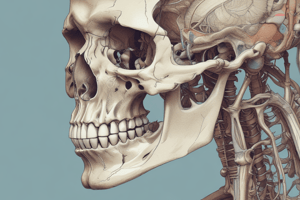Podcast
Questions and Answers
Which type of bone is characterized by being cylinder-like in shape and longer than it is wide?
Which type of bone is characterized by being cylinder-like in shape and longer than it is wide?
- Short bones
- Flat bones
- Irregular bones
- Long bones (correct)
What is a characteristic of sesamoid bones?
What is a characteristic of sesamoid bones?
- They are small and round, and embedded in tendons (correct)
- They are irregular in shape
- They are cylinder-like in shape
- They are flat and plate-like
Which type of bone is an example of a humerus?
Which type of bone is an example of a humerus?
- Flat bone
- Irregular bone
- Long bone (correct)
- Short bone
What is the primary characteristic of flat bones?
What is the primary characteristic of flat bones?
Which type of bone is an example of a vertebra?
Which type of bone is an example of a vertebra?
What is the main criterion used to classify joints into different categories?
What is the main criterion used to classify joints into different categories?
What type of joint has a fluid-filled cavity called a bursa?
What type of joint has a fluid-filled cavity called a bursa?
What is a characteristic shared by cartilaginous and fibrous joints?
What is a characteristic shared by cartilaginous and fibrous joints?
Which of the following is an example of a movable joint?
Which of the following is an example of a movable joint?
How many main types of joints are there based on their structure?
How many main types of joints are there based on their structure?
Flashcards are hidden until you start studying
Study Notes
Bone Classification
- Long bones have a cylinder-like shape, are longer than they are wide, and are the strongest bones in the body.
- Examples of long bones include the humerus (upper arm), femur (thigh), clavicle (collarbone), radius (forearm), ulna (forearm), phalanges (fingers and toes), tibia (lower leg), and fibula (lower leg).
Short Bones
- Short bones are similar in length in all dimensions.
- Most carpal (wrist) and tarsal (ankle) bones are examples of short bones.
Flat Bones
- Flat bones are flat and plate-like in shape.
- Examples of flat bones include the bones of the skull (cranial bones), rib cage, and scapula (shoulder blade).
Irregular Bones
- Irregular bones have an irregular shape.
- Examples of irregular bones include the vertebrae (spine), hip bones, and mandible (jaw).
Sesamoid Bones
- Sesamoid bones are small, round, and embedded in tendons.
- The patella (kneecap) is an example of a sesamoid bone.
Joints Classification
- Joints are categorized into three types based on their range of movement: immovable, partly movable, and movable.
- Examples of movable joints include the shoulder, which can move in multiple directions.
Structural Classification of Joints
- Cartilaginous joints are connected by hyaline cartilage and lack a joint cavity.
- Fibrous joints are connected by dense connective tissue and also lack a joint cavity.
- Synovial joints have a fluid-filled cavity called a bursa, which surrounds and cushions the articulating bones.
Studying That Suits You
Use AI to generate personalized quizzes and flashcards to suit your learning preferences.




